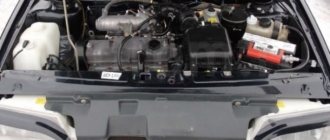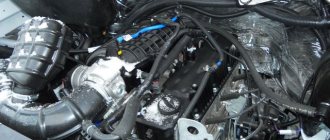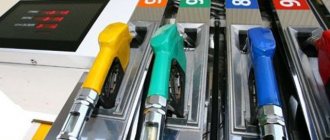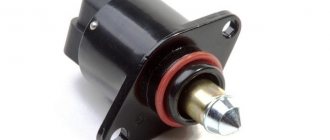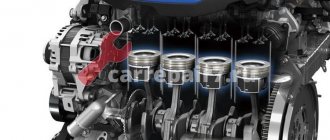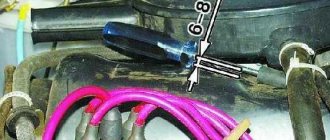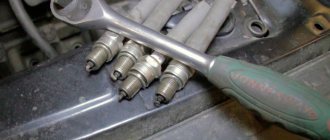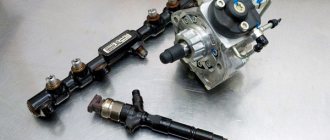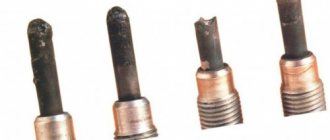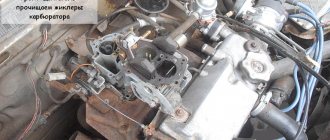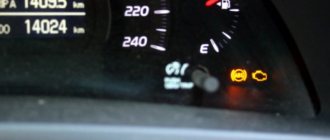Increasingly, car owners decide to undergo such a procedure as washing the engine of their favorite car. It is certainly necessary to clean the power unit, since its condition and durability depend on it. But sometimes after water procedures the engine gives drivers a surprise - the engine stalls or does not start. In order to respond to such a turn of events in a timely manner, it is necessary to understand what actions to take next.
Various problems may occur after washing your car.
The main reasons for unstable engine operation after washing
As a rule, if problems arise with the engine after washing, car owners complain that the power unit is not working. That is, not all cylinders are working. The following signs and symptoms may also be observed: loss of power, increased fuel consumption, problems with starting the internal combustion engine, etc.
Note that there are not so many main reasons why the engine jerks after washing:
- damp candles. Water enters the spark plug well, as a result of which a spark does not occur at the spark plug electrodes.
- It also happens that there is a spark, but it is not powerful enough. If the spark plugs work in this state for a long enough time, they may well completely fail;
- damage to sensors by detergents (if they contain alkali);
- damage to elements in the engine compartment due to excess water pressure during washing;
As you can see, if the car jerks after washing the engine, all problems arise due to errors during the process of removing contaminants, as well as as a result of neglecting basic rules and recommendations.
Most often, drivers strive to wash their car and engine cheaply and with the least amount of effort. To do this, many people prefer to use equipment that creates a high-pressure water jet to wash the engine.
For example, regular car shampoo and Karcher engine wash. The result is moisture ingress, unstable operation of the internal combustion engine or the inability to start it. In the worst case, a short circuit may occur.
Reasons for car shaking after washing
No spark
Since a high-pressure apparatus is used when washing the engine, the amount of water it produces is enormous. Some of it ends up in spark plug wells on sixteen valve, two shaft or more engines. Car owners, of course, do not suspect this; they start the engine, the coil begins to spark through the water onto the engine ground and immediately closes. If in such a situation you do not turn off the engine and drive further under load, the coil can pierce the primary circuit so much that reverse current flows towards the electronic control unit and burns through the transistor that controls the coil and nearby circuit board tracks. Then the brain cannot be restored; you will have to buy a new one. It's not a cheap purchase and most cars don't have them in stock.
Often, when selling a car, the engine is washed in order to hide oil leaks, or simply for beauty in order to sell it at a higher price. For example, on vases with an eight-valve engine, the ignition coil, which is located opposite the cooling radiator, is immediately filled. It strikes a spark and covers high-voltage wires and spark plugs along the chain. It is rare, but there is a breakdown of the ECU itself, as described above.
Thus, when water gets into the spark plug wells after washing, the engine shakes and the car jerks violently. Until the water is removed from there and the broken parts of the high-voltage circuit are replaced, the motor will operate unstably. After washing the engine, you can leave the car with the hood open for a while and wait until all the parts dry. The best option, of course, would be to blow the engine with air from the compressor.
Action of alkali
Shampoos for washing cars and engines have a powerful alkaline composition that is designed for oil and fat deposits. He washes them off in one go. But when they wash the engine with it, contact also occurs with the plastic of sensors, high-voltage wires, and ignition coils. The composition of the product begins to corrode, especially on older cars, the wiring and short circuits appear, which leads to tripping, and worst of all, when the car does not start.
Mechanical failure
Mechanical damage to engine parts from a high-pressure washer can be an important factor. The connectors of the sensors, electronic control unit, and ignition coils can be damaged.
The most dangerous thing is water entering through the air filter. When starting, it can get into the combustion chamber and a water hammer will occur, but this is a very rare and practically unrealistic case. This can happen, for example, if the air filter is not installed at all.
What can be considered normal and what not?
It is not always necessary to fall into despair and panic. The fact is that in some cases the problems are not significant, and sometimes there are none at all. A striking example of this is self-diagnosis of the system state. It is performed when you insert the key into the ignition and turn it to the operating position. In this case, the “check” should be lit. It usually goes out either after a few seconds or after starting the engine. At this time, all the dashboard lamps should light up, which indicates their serviceability.
Many people don’t know about this, this applies, of course, to beginners
If you started the engine and everything was fine, and after some time problems appeared, you need to pay attention to the ECU. It is likely that due to its unstable operation the “check” lights up
Toyota's latest models allow you to perform self-diagnosis of the ECU and determine exactly what the problem is.
After washing the car began to twitch: why is this happening?
Car owners try to maintain the car in good condition and monitor its external presentability. Technical inspection and washing have become common procedures for motorists. Some of them make excessive efforts to keep their cars clean and manage to wash the engine incorrectly. After such events, it is quite natural that the car begins to twitch, and the engine itself begins to trip. It is necessary to wash the engine very carefully, otherwise the consequences may cost the car owner a large amount of money and significantly impact the personal budget. Let's try to find out why the car jerks after washing and what to do in this case.
The main causes of tripling
There are many reasons and factors that are a catalyst for the onset of disruptions in the performance of certain components in the machine. Engine tripping is an unpleasant breakdown, but it occurs with enviable frequency on both outdated and modern models. The reason is vibration or a large amplitude of work that exceeds normal work under similar conditions and circumstances. Even if the car has 8 cylinders, the failure of just one already leads to characteristic problems.
Service station specialists or simply experienced drivers identify the following main factors that can lead to such a violation:
After washing or wiping the engine with a damp cloth, the car starts to shake because as a result of the cleaning procedure, water got into it.
Tribbing occurs due to contact of spark plugs with liquid, which do not produce the spark necessary to start the engine.
Also, problems with the car’s engine may occur due to the failure of sensors (therefore, their performance must be constantly monitored). Sensors are sensitive mechanisms that can break if car shampoo gets into them.
The equipment used in car washes (professional or private) can be the main factor that negatively affects the performance of the motor, since the washing devices operate under high water pressure. That is why it is better not to wash the engine in this way.
When the engine starts to stall after washing, the following is observed:
Increased amplitude of its work.
Constant vibration.
In difficult situations - complete failure of this element.
Why does the car jerk after washing the engine? Read it
Many car enthusiasts wonder why the car jerks after washing the engine. This is an unpleasant situation. This behavior can scare even experienced drivers, let alone beginners. Usually, the reason for such indistinct behavior of the car is an unsuccessful wash. Therefore, the owner needs to know how to properly wash the engine of his vehicle. It is also advisable to familiarize yourself with how to fix an existing problem. In fact, the reasons for the motor tripping lie on the surface, and no special skills should be required in identifying and eliminating the problem.
What systems is the ECM responsible for?
To understand the problem in more detail, you need to understand where to go. So, a modern electronic control unit reads information from the following systems:
- cooling;
- nutrition;
- lubricants;
- exhaust gas removal;
- ignition
The most common problems are with engine cooling and lubrication. For example, a faulty thermostat will lead to rapid overheating of the internal combustion engine. If the driver is not informed about this in the form of an appropriate signal, then you can find out about it when steam comes out from under the hood, but in this case it may be too late.
Try to check the engine oil level, the condition of the cooling and power systems as often as possible. All this should work if you don’t want to meet “Jackie-Chan” one-on-one at night on the track.
How to protect from water when washing
The best remedy is, of course, not to wash the engine. But how to remove oil stains? There are several ways. The most neutral one, which does not lead to consequences, is to buy a grease remover from dishes in a store, spray it on and wait a few minutes until everything drips down. Then use a compressor to thoroughly blow through all engine parts. But no moisture or water.
The second way is to mix a little gasoline with mallow - a product that many car mechanics use to wash their hands, pour this mixture into a spray bottle, spray it on the engine and also air dry.
System pressure problems
In addition to the oil pump, there is also a gasoline pump. One creates the necessary pressure in the engine for lubricant circulation, and the second - in the gas tank. But that's not the point. Both the first and second pumps gradually wear out. For example, a gasoline engine suffers greatly if you regularly drive with a light bulb, although this does not apply to all cars.
The oil pump can fail if there is no lubrication in the system and the internal combustion engine is running, which should not be allowed. If the pump fails, you will immediately see an error. If the problem is oil, then the “oil can” indicator will light up, which requires an immediate stop and checking the engine lubrication level. If something happens to the fuel pump, then you simply won’t go anywhere, since there will be no fuel supply.
Other faults
Sometimes drivers encounter various engine problems that are not directly caused by washing the power plant, and since some of these problems are common, it is worth knowing about them.
For example, sometimes drivers, having underestimated the terrain on a particular section of the road, drive into a puddle that turns out to be unexpectedly deep. In such situations, the engine often stalls. If the unit is silent, then this means only one thing: water has flooded the distributor cover, wires and coil. With such a diagnosis, you should not waste time trying to start the car. It is better to find a clean rag and thoroughly wipe the flooded parts of the engine until they are dry. As a result, the unit usually starts.
If you don’t want to get out of the car into the arms of a cold and deep puddle, you can simply wait 15-20 minutes - during this time the wires should have time to dry.
Broken timing belt
Another unpleasant circumstance that drivers face is a suddenly stalled car. If the car has a motor with a timing belt, then most likely the reason for the failure of the unit lies in its (belt) breakage. A sign of a broken belt is a starter that turns the engine faster than usual.
If everything is in order with the belt, then you should perform the following steps:
Pay attention to the fuel pump and make sure that it pumps, check for a spark (if there is one), inspect the carburetor and make sure that it is not clogged and there is no overflow (to do this, you need to remove the air filter cover to see if gasoline is flowing)
Electronic ignition can also complicate life, because of problems with which the engine sometimes stalls and in some cases stalls. The insidiousness of this breakdown lies in the fact that it can make itself felt somewhere in the wilderness, when there is nowhere to wait for help. To avoid such troubles, you need to check the ignition wires leading from the distributor to the spark plugs before leaving.
Video about checking ignition wires:
If the wires are old, then there is a risk that they will periodically fly off the spark plugs. Such jumps are dangerous for two reasons: a break in the power supply to the spark plug and overvoltage (when several wires fly off), which can damage the ignition coil. In turn, without this coil the unit will not be able to start. Therefore, it is recommended to replace worn ignition wires without delay.
Many car enthusiasts have encountered such a problem as engine failure in winter after ideal operation in summer. Spare, oil-free spark plugs and simple manipulations with the cylinders will help you get out of such an uncomfortable situation.
Before starting the car in sub-zero temperatures, you need to unscrew the spark plugs, use a syringe to pour 5 cubes of motor oil into any two cylinders, and use the starter to “drive” the engine a little. When the procedure is completed, you can screw in the spare spark plugs and start the car. The unit should start without problems. In this situation, oil helps because its presence in the cylinders significantly increases compression, as a result of which the working mixture ignites and the engine starts.
Car failure in winter
The conclusion is simple: in order for the engine to start and not stall, it must be protected from moisture and always be prepared for easy resuscitation of the engine compartment mechanisms.
Tips for restoring the performance of the power plant
If cleaning the engine compartment results in the engine being unable to start, the car owner should not panic and immediately call a tow truck. You can correct the situation right on the spot. It is enough to dry the places where liquid accumulates. It is recommended to adhere to the following instructions:
- Open the hood and visually inspect the power plant and other components. Any water found must be carefully removed;
- Remove the terminals from the battery and remove oxides;
- Wipe the high-voltage wires along the entire length;
- Unscrew the spark plugs and let them dry. Make sure there is no water in their planting areas;
- If there is a distributor, it must be dismantled. After this, remove the lid and wipe everything dry;
- Open the air filter housing and make sure there is no liquid in it;
- Check the status of the alarm.
If the above steps did not help, then the malfunction did not arise as a result of the engine being washed, but for other reasons. In this case, it is necessary to begin troubleshooting components and parts. For example, a cracked distributor cap could perform its functions when dry, but the appearance of moisture completely rendered it inoperable.
What should the driver do?
If there is a problem, the engine will definitely stall. It’s quite difficult not to notice this. With such a pronounced nature of the violation, it is not recommended to travel by car. It is necessary to check the engine for serviceability and identify violations immediately, otherwise it can lead to more serious consequences. To definitely protect yourself from an unpleasant scenario of events, you need to perform the following sequence of actions:
- Bring the car to the premises for diagnostics;
- Inspect and then wipe with dry material the contacts, wiring and the most important ignition elements;
- Remove the coils and blow them out using compressed air;
- Remove excess moisture from the candles (this is done using compressed air);
- Assemble and start the engine.
After starting, the car needs to run continuously for some time. 3 minutes is enough for this. Next you need to drive the car and see if there is any friction in the engine itself. The problem is considered successfully resolved if no violations were identified as a result of the inspection.
Watch a video about how not to wash your engine:
How to fix the problem and what the driver needs to do
Since the main cause of a malfunction in the form of tripping is water, the first thing the driver should do is try to remove it as quickly and thoroughly as possible from the surface of the engine or spark plugs
It is important to remember here that the work must be carried out in a sink. Stages:. The car must be parked in a dry place (the optimal solution is in a warm garage)
You need to park the car in a dry place (the optimal solution is in a warm garage).
Then wipe all existing electrical wiring of the machine.
Wipe the spark plugs thoroughly (in most cases, this is the point that car enthusiasts miss).
Finally, it is necessary to check the battery terminals in order to ensure the functionality of this element.
What to do before contacting the service
An experienced driver or a novice should take into account that in some cases, a layer of dirt formed on the terminals, which has a pronounced dark color, causes the engine to start shaking after washing. It is eliminated with water, which leads to a malfunction
This is why it is important to wipe the terminals dry after cleaning and carefully tighten them.
It becomes more difficult when, after washing, it turns out that water or condensate particles, elements of car cosmetics or other liquid components have penetrated under the hood
In this case, it doesn’t matter at all how the washing was done: independently or by professionals, because such a nuisance can happen to anyone. In order to eliminate the consequences of moisture or condensation penetration, you will need:
Turn off the car (turn off the ignition).
Turn it on again (check operation).
In 90% of cases, after cleaning using any liquids and even shampoos, violations are present there.
If you have an ignition distributor, you will first need:
Disassemble the distributor.
Remove residual water and moisture under the lid.
Additionally, wipe the armored wires.
Check the spark plug windows to ensure they are completely dry.
If the presence of water in the spark plugs is detected, it is not recommended to start the engine with choke. Such an action will not have the desired effect (it will not stop tripping). When blowing spark plugs, it is best to remove the choke, then squeeze out the gas and only then start the engine.
Ignition works without distributor
It also happens that the car has an ignition without a distributor. In this case, to restore functionality, the car owner will need:
Unscrew the coils (all of them).
Remove them to make them easier to work with.
Blow them out.
Wipe so that the spark plug wells are dry.
It is recommended to lubricate wires with a high voltage rating with a special compound called WD-40. This will make it possible to maintain the functionality of the engine with the maximum probability after washing.
Additional recommendations
If the engine troubles significantly after washing, even after the measures taken, it is recommended to pay attention to the following:
are there any cracks or deep chips in the distributor body;
What condition are the electrical wires of the car?
The engine can also be damaged after washing only from the outside.
Timing problems
It must be taken into account that after contact with water, the timing belt may break. A quick knock of the starter will help determine the malfunction. If a break does not occur, but there is a knocking sound, then the problem may lie in problems with the ignition spark supply or with the carburetor (if the car has one). Electronic ignition should not be overlooked, since after contact with water the engine may start to troit and the car may stall while driving.
Is it necessary to wash the engine
There are many opinions and rumors regarding this issue. There are always pros and cons, pros and cons. One of the reasons why the engine is washed is heavy leaks of oil, antifreeze, or antifreeze. The biggest cause of this, of course, is the oil sludge on the engine. It interferes with normal cooling in the summer and the engine overheats. To see and then eliminate where the oil is leaking from, it’s a good idea to wash the engine with special chemicals and knock it all down under pressure with water. The coolant corrodes the contacts, engine harness wires, electronic control unit and other electrical components of the internal combustion engine, which can adversely affect the operation of the engine.
If the car is often driven outside the city, in the forest, or in rough terrain, dirt sticks heavily to the engine, cooling fan, and radiator. If you do not knock the clay off the fan in time, it will create vibration and simply break the bearing over time, and you will have to replace it. And the cost reaches, especially on foreign cars, colossal amounts.
This way you can be sure that engine washing is necessary in some cases. But doing it just for the sake of prevention or dust removal does not make any sense. After all, the price of such a procedure can amount to tens, or even 100 thousand rubles. One of the expensive components in the engine compartment is the electronic engine control unit. Its cost is measured in tens of thousands of rubles, it all depends on the make of the car. The second most expensive part and the risk of breakdown is the ignition coil. It's not cheap. Why are these expensive spare parts listed in the engine compartment? The whole point is that when washing the engine, the car starts to shake, precisely because of them.
Let's take a closer look at the nuances of the car shaking after washing the engine, how to identify the cause of the shaking, eliminate it on site or in a car service, and how to prevent water from getting on electrical elements.
How to identify a malfunction
The breakdown can be visually determined by the following behavior of the car: if the idle speed is started (not aimed at making the car move), the faulty engine will not operate as intended by the manufacturer. Also, his work may be accompanied by failures.
An additional element by which the malfunction is determined: the car starts, but begins to stall. The more severe the malfunction, the more often such engine stops occur. Even after starting the car, the car may begin to twitch noticeably.
It is also recommended to pay attention to the presence of the following “symptoms”:
Fuel consumption increases sharply (up to 2-3 times in total for a certain period of road) (gasoline or diesel does not matter in this case). For example: 50 liters was enough to travel 500 km, but after a malfunction the same amount will only be enough for 300 km
The usual power is noticeably lost - the declared horsepower is no longer enough for the car to perform usual actions (for example, it becomes more difficult to overcome poorly cleared roads in winter).
There are problems starting the engine.
In 90% of cases, problems after washing are observed in the cold season or in regions where the climate is unstable. In most cases, frozen water leads to the formation of ice, which also negatively affects overall performance.
Let's sum it up
As you can see, if after the driver has washed the engine, the car jerks, in the vast majority of cases the moisture that has got into the spark plug wells, high-voltage wires, ignition coil or distributor is to blame.
Also, do not use alkaline solutions or detergents containing other aggressive substances to wash the engine, which can damage the ECM sensors, insulation or disrupt the operation of individual elements. You should never wash the engine with a high-pressure water jet without preparing the car.
Then you need to close the hood, after which it is better to leave the car for some more time (preferably overnight) right inside the car wash. As a rule, during this time the moisture will evaporate from hard-to-reach places (provided there is no strong humidity in the room itself), after which the engine should start and continue to operate without problems.
Why does the engine start to stall and the “check” light up on the dashboard: the main and most common reasons for the engine to stall and the “check” to light up.
The engine stalls when hot (after warming up): common causes of unstable operation of the internal combustion engine after reaching operating temperatures. Diagnostics, final advice.
The engine does not start after washing the engine: the main reasons why the power unit cannot be started. What can be done in such a case.
How to properly wash the engine and engine compartment of a car with a Karcher. Pros and cons of the method, professional and self-washing. Possible malfunctions after washing the engine.
Is it worth washing the engine with steam: the pros and cons of the method. What could be the consequences after washing the engine and engine compartment with water, chemicals, or steam?
How to safely wash a car engine without water: common methods. Cleaning the engine compartment and internal combustion engines using special means or steam washing. Adviсe.
Source
How to fix the situation
Since water is the cause of problems after washing, it is necessary to take all measures to remove it.
To do this, you need to place the car in a dry place and thoroughly wipe all the wiring or blow it out with a compressor. The same actions should be applied to the armored wires of the spark plugs.
Next, it is important to pay attention to the battery terminals and make sure they are securely fastened
Sometimes a gray coating appears on the terminals, which impairs contact. It (plaque) can be easily removed with water. When the driver has washed the terminals, he must wipe them until they are perfectly dry and tighten them thoroughly.
The battery terminals must be securely fastened
If water did not enter the engine compartment during washing, then the above measures should be sufficient to bring the engine into working condition.
In the event that moisture has penetrated under the hood, a number of additional efforts will have to be made to bring the unit in order.
Tidying up the engine compartment
You need to start inspecting the engine compartment of a car that stubbornly refuses to start by checking the ignition system. It is in this part of the unit that problems most often arise after the owner has carefully washed the power plant of his car.
In those cars that are equipped with a distributor structure, it is necessary to disassemble the distributor itself, and then remove any remaining moisture under the cover. And only when everything is thoroughly blown and wiped, you can move on to the armored wires, wiping them until they are dry.
It is important to remember about spark plug wells - they must be thoroughly dried
Photo of distributor
Speaking about blowing out spark plug wells, it is worth noting the following: often when spark plugs are flooded during a wash or under other circumstances, drivers try to start the car using a choke, but this strategy is ineffective. The best thing you can do to blow out the spark plugs is to remove the choke, press the gas pedal, and start the engine. Thus, high-quality cleaning will be carried out, and the unit will start.
If it so happens that the car has a distributorless ignition system, which is equipped with an individual coil for each individual cylinder, then you will have to be patient. The shutter speed will be needed in order to remove all the coils one by one, while blowing and wiping the spark plug wells. In this situation, there is a plus and a minus: the distributor cover is more difficult to remove than the coils, but some of the coils may be difficult to access, which also entails considerable effort and time.
When cleaning spark plugs, you need to make sure they are in working order. To do this, you need to unscrew them and carefully inspect them.
Spark plugs must be in working order
When all procedures are completed, you can try to start the car.
To save yourself from contemplating how the car jerks or does not start, you need to clean the distributor cover, high-voltage wires, and ignition coil from dirt and deposits, and lubricate them with WD-40 liquid or silicone grease. Such measures will not only help maintain the performance of the engine that has been washed, but will also allow it to operate without problems in wet weather.
Another reason for constant problems with the engine may be a breakdown in the armored wires or distributor housing. In this condition, the unit also suffers from the fact that the owner of the car only washed the body of his car. Correcting the situation is quite simple - you need to find the part that has a crack (wires, distributor) and replace it.
Armored wires
What to do if the engine misfires after washing
Many car owners wash their car engine themselves.
Of course, it is necessary to clean it, because its performance and durability depend on how clean it is. However, sometimes after such a procedure the power unit presents motorists with trouble - it starts to misfire or the car refuses to start. In order to react in a timely manner to such a turn, every driver must know what to do and how to proceed. Let's first understand the concept of “engine troit”. Troubleshooting is an engine malfunction in which any of the 4 cylinders stops working. The cause of such a breakdown may be vibration due to the large amplitude of operation of the car engine. A power unit with a faulty cylinder will work intermittently.
Sometimes when driving with a dead cylinder, the car jerks noticeably and fuel consumption increases. The power also drops, and difficulties arise in starting the unit, especially after a winter wash.
The engine may malfunction after a car wash for the following reasons:
1. Liquid may get into the spark plug wells. Due to water, the spark plug does not produce a spark, and the cylinder, of course, does not function.
2. Problems with the motor can also arise due to sensor failure if car shampoo gets into them.
3. Washing equipment is often used to supply water under high pressure. Such cleaning of the unit can lead to failure of easily vulnerable parts. Therefore, automakers do not recommend washing the engine under high pressure.
When summarizing the causes of breakdowns of an engine that has undergone cleaning, it all comes down to the ingress of liquid into those parts of the unit that can only operate normally when dry.
How to fix the situation
Since the cause of malfunctions after a car wash is water, everything possible should be done to remove it.
To do this, you need to park the car in a dry place and wipe all electrical wiring dry. The same should be done with the armored wires of the spark plugs. Then it is important to check the battery terminals and make sure that everything is in order with them.
The contact can be worsened by a gray coating formed on the terminals. It can be removed with water. The washed terminals must be wiped dry and tightened properly.
But if the liquid did not get under the hood during the washing process, then the measures described above will be enough to bring the engine into working condition.
If water has penetrated into the engine compartment, then a lot of effort will have to be made to put the power unit in order.
Putting things in order under the hood
First of all, you should check the operation of the ignition system, since this is where problems most often arise after washing.
In cars equipped with an ignition distributor, you need to disassemble the distributor and then remove any remaining water from under the cover. After everything is well wiped, you need to wipe the armor wires dry. We should not forget about candle windows - it is important that they are dry.
Since we are already talking about blowing out spark plug windows, it makes sense to note: many drivers, with flooded spark plugs, try to start the car engine with choke. But this is not very effective. When purging the spark plugs, you need to remove the choke, squeeze out the gas and start the engine. This way you can carry out high-quality cleaning and start the car.
If the vehicle has a distributorless ignition, and each cylinder has an individual coil, then the motorist will have to remove all the coils, blow out and wipe the spark plug wells dry. In this situation, there is both a plus and a minus: it is more difficult to remove the cover from the distributor than the coils, but it will also be difficult to reach some coils.
To make sure that the spark plugs are in working order, they will have to be unscrewed and checked.
After completing all the necessary procedures, you can try to start the car.
To prevent the car from jerking, the distributor must be cleaned, and the high-voltage wires and ignition coils must be properly lubricated. This can be done with WD-40. This will allow you to maintain the functionality of the unit after washing.
Another cause of frequent problems with a vehicle’s power unit can be a crack in the distributor housing or a breakdown of armored wires. The power unit can also malfunction after washing the car body. This situation is very easy to fix - you need to find the cracked part and replace it with a new one.
From time to time, motorists have to deal with various problems in the operation of the unit. Their cause is often not engine washing. And since some malfunctions occur quite often, it will be useful for drivers to know about them.
Sometimes drivers, underestimating a specific section of the roadway, climb into a deep puddle in which the engine stalls. If this happens, it means only one thing: liquid got under the distributor cover and flooded the coil and wires. In this case, you will have to find a clean cloth and wipe the motor dry.
The next unpleasant moment that motorists have to deal with is suddenly a car. If an engine with a timing belt is installed in it, then, most likely, its breakage is to blame. A sign of his impulse will be a rapidly spinning starter.
But if the belt is intact, then you should check the fuel pump and make sure that it is working normally, check the ignition spark and the carburetor.
Electronic ignition can also cause problems. If this is the problem, the engine will stall and even stall.
How to quickly find the cause of the problem
In some cases, it is extremely simple to determine the nature of the malfunction, and the same applies to its elimination. The fact is that the car has many warning lamps on the instrument panel. For example, the low oil pressure light came on and at the same time the check light came on. Whether you have an Opel or a Nissan, there is not much difference. Here it is clear that the problem is the lack of pressure in the lubrication system.
The same applies to the cooling system. It has a rather complex structure and is responsible for effective heat removal from the engine. Elements such as a pump are responsible for circulation, and the filler cap maintains a certain pressure in the system. If something goes wrong, the engine heats up and the coolant temperature needle creeps up. When boiling, the “check” will light up. Here, too, it is clear that the problem is in the cooling system, so you need to start with it.
Vehicle system diagnostics
Some car brands allow you to perform self-diagnosis from the key. In particular, this applies to American cars (such as Chrysler or Dodge) and some European ones. Self-diagnosis allows you to identify and fix the problem yourself if it is not serious.
Advanced technologies make it possible not only to display the error code on the screen, but also to immediately obtain a decoding, which will significantly simplify the task for the driver. In this case, you will immediately understand what’s going on and handle it yourself. In other cases, in order to find out what the “check” is doing wrong, you need to connect a special scanner. This is done at the service station, however, a lot depends on the make of the car. If the “check” on a VAZ lights up, then it is easiest to identify and fix the problem, since the system is not saturated with electronics. But fixing a problem on a Toyota or Volvo will be much more difficult.
Other Possible Causes
The “Check Engine” sign may light up for other reasons:
- Low quality fuel. The solution to the problem is to drain the bad gasoline and fill it with better quality.
- No spark from the ignition coil. If necessary, install a new coil.
- Injectors. Deposits on the surface of the injectors can also cause the error, especially if low-quality fuel is used.
- Without pump. To check it, measure the pressure in the rail - it should be more than 3 atmospheres. Replace the pump if necessary. In some cases, cleaning the fuel filter helps.
If the problem is really related to the filter or fuel pump, then before the sign lights up you should feel a deterioration in engine dynamics, instability of its operation, etc.
If all these actions did not bring any result, and the Check Engine still remains on, then the only way out is to visit a service center to diagnose and fix the error. There is no need to hesitate, because this can be costly for both you and your car’s engine.
After washing, the car jerks: what was the reason?
The car behaves this way for a reason. In many cases, this factor indicates a malfunction of the engine itself or improper operation of the cylinders. This happens for a number of reasons, the main of which are directly related to:
When liquid (water) gets into the spark plug wells, a spark does not form.
The charge supplied to the spark plugs spreads in different directions and, with prolonged use in this mode, contributes to the complete failure of the spark plugs. With sensors, problems occur due to alkaline cleaning agents used for cleaning. If they get on the sensors, this usually leads to their unstable operation and subsequent complete breakdown. As for damage to individual engine components, malfunctions in them arise due to inaccurate washing. Especially when it comes to high pressure washing. Moreover, it is very important to note here that there are many more problems after careless washing. Many of them are hidden and manifest themselves after a fairly long period of time.
